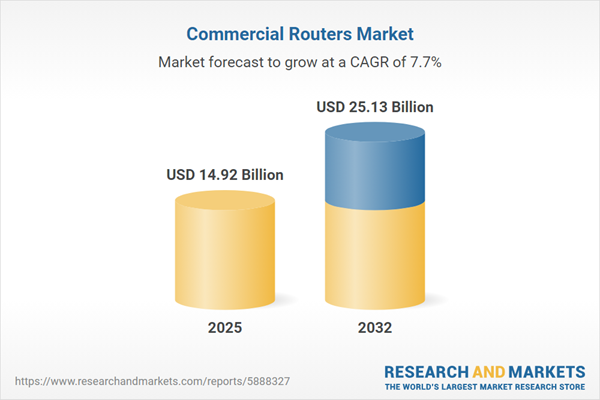Speak directly to the analyst to clarify any post sales queries you may have.
The commercial routers market is evolving as enterprises and public organizations prioritize secure, agile, and scalable networking infrastructure to support shifting operational demands and regulatory landscapes. Addressing connectivity, resilience, and compliance now sits at the core of technology investment strategies.
Market Snapshot: Commercial Routers Market Growth and Drivers
The global commercial routers market demonstrates sustained expansion, with revenue projected to climb from USD 13.84 billion in 2024 to USD 14.92 billion in 2025, reaching USD 25.13 billion by 2032 at a CAGR of 7.74%. This growth trajectory reflects ongoing commitments to digital transformation across enterprises, government, and vertical sectors seeking modern, scalable network infrastructure. Key market influences include rising adoption of advanced security frameworks, demand for seamless cloud migration, and significant investment in software-defined networking. The shift toward remote work, emphasis on edge computing deployments, and integration of 5G technology are accelerating the deployment of adaptive network solutions suited to contemporary business agility and operational resilience requirements.
Scope & Segmentation
This report provides detailed insights tailored for decision-makers assessing commercial router investments, highlighting the market landscape, segmentation, and core drivers influencing purchasing strategies across industries and geographies. Understanding these factors is critical for optimizing infrastructure and managing compliance in an evolving network environment:
- End User Segments: Data centers rely on scalable routers to address increasing workloads. Enterprise IT leaders are focused on flexible security and reliable data transfer. Government agencies target solutions that satisfy regulatory and operational standards. Retailers emphasize seamless multi-site connectivity to boost customer experience, and telecom providers require high-capacity, dependable routers for backbone network reliability.
- Deployment Categories: Core routers maintain stability and robust global connectivity. Distribution routers facilitate operational control and support risk segmentation across dispersed locations. Edge routers enable secure branch and remote office access, supporting the shift to mobile and distributed operations.
- Regional Coverage: The Americas, Europe, Middle East & Africa, and Asia-Pacific feature diverse regulatory and technological adoption patterns. These variations affect how organizations plan procurement, manage compliance, and implement modernization initiatives in line with local and regional priorities.
- Leading Companies Analyzed: Competitive dynamics are shaped by major vendors including Cisco Systems, Huawei Technologies, Hewlett Packard Enterprise, Juniper Networks, Nokia Corporation, Dell Technologies, NETGEAR, TP-Link Technologies, D-Link Corporation, and Ubiquiti Inc. Each brings unique technology portfolios and strategic direction that set industry benchmarks and influence future innovation.
Key Takeaways for Senior Decision-Makers
- Hybrid network architectures enhance operational flexibility, allowing organizations to scale and adapt connectivity strategies as business requirements shift and grow.
- AI-driven automation and expanded edge deployments support better network manageability, giving IT executives improved monitoring and operational control over complex structures.
- Zero-trust security frameworks are essential as organizations extend their footprint, strengthening compliance and protecting distributed assets across varied locations and environments.
- Strategically integrating core, distribution, and edge routers equips businesses to address regulatory, operational, and cybersecurity needs across intricate networks.
- Prioritizing energy-efficient networking helps meet sustainability objectives and aligns with emerging global environmental regulations, while lowering operational costs over time.
- Implementing modular, software-defined solutions accelerates the onboarding of new technologies, delivering agility as networks evolve and market conditions shift.
Tariff Impact and Strategic Sourcing
Recent tariff changes on U.S. router components have increased supply chain expenses for manufacturers in the commercial routers market. Organizations have responded by expanding supplier networks, reviewing production locations, and partnering closely with established vendors. These actions enhance procurement flexibility, improve transparency in sourcing, and mitigate operational risks as international trade and regulatory environments continue to shift.
Methodology & Data Sources
The findings in this report are drawn from primary interviews with IT and procurement leaders, complemented by expert commentary and a systematic analysis of evolving technology and regulatory requirements. A mix of direct and secondary data ensures that recommendations are actionable for organizations planning commercial router investments.
Why This Report Matters
- Presents a unified view of telecommunications and cloud networking trends, helping IT leaders align infrastructure planning with evolving business objectives and technology standards.
- Enables executive teams to anticipate compliance shifts and technological advancements, supporting effective risk management and future-ready procurement strategies.
- Delivers actionable guidance that helps senior decision-makers control network investment and ensure operational continuity amid security and sourcing challenges.
Conclusion
The commercial routers market continues to play a vital role in enabling secure, efficient, and compliant enterprise operations. This report supports leaders in making informed, strategic choices for sustained growth and preparedness in a changing business landscape.
Additional Product Information:
- Purchase of this report includes 1 year online access with quarterly updates.
- This report can be updated on request. Please contact our Customer Experience team using the Ask a Question widget on our website.
Table of Contents
3. Executive Summary
4. Market Overview
7. Cumulative Impact of Artificial Intelligence 2025
Companies Mentioned
The companies profiled in this Commercial Routers market report include:- Cisco Systems, Inc.
- Huawei Technologies Co., Ltd.
- Hewlett Packard Enterprise Company
- Juniper Networks, Inc.
- Nokia Corporation
- Dell Technologies, Inc.
- NETGEAR, Inc.
- TP-Link Technologies Co., Ltd.
- D-Link Corporation
- Ubiquiti Inc.
Table Information
| Report Attribute | Details |
|---|---|
| No. of Pages | 189 |
| Published | November 2025 |
| Forecast Period | 2025 - 2032 |
| Estimated Market Value ( USD | $ 14.92 Billion |
| Forecasted Market Value ( USD | $ 25.13 Billion |
| Compound Annual Growth Rate | 7.7% |
| Regions Covered | Global |
| No. of Companies Mentioned | 11 |









